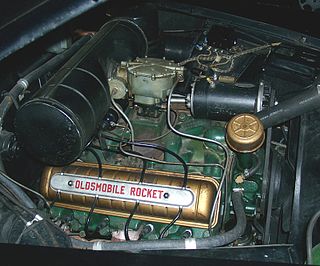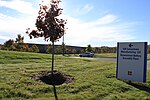
Oldsmobile was a brand of American automobiles, produced for most of its existence by General Motors. Originally established as "Olds Motor Vehicle Company" by Ransom E. Olds in 1897, it produced over 35 million vehicles, including at least 14 million built at its Lansing, Michigan factory alone.

The General Motors 60° V6 engine family is a series of 60° V6 engines produced for both longitudinal and transverse applications. All of these engines are 12-valve cam-in-block or overhead valve engines, except for the LQ1 which uses 24 valves driven by dual overhead cams. These engines vary in displacement between 2.5 and 3.4 litres and have a cast-iron block and either cast-iron or aluminum heads. Production of these engines began in 1980 and ended in 2005 in the U.S., with production continued in China until 2010. This engine family was the basis for the GM High Value engine family. These engines have also been referred to as the X engines as they were first used in the X-body cars.

The Buick V6 was an OHV V6 engine developed by the Buick division of General Motors and introduced in 1962. Originally 198 cu in (3.2 L) and initially marketed as Fireball, it later became popularly referred to as the 3800 for its various 3.8 L (230 cu in) incarnations.

The Oldsmobile V8, also referred to as the Rocket, is series of engines that was produced by Oldsmobile from 1949 until 1990. The Rocket, along with the 1949 Cadillac V8, were the first post-war OHV crossflow cylinder head V8 engines produced by General Motors. Like all other GM divisions, Olds continued building its own V8 engine family for decades, adopting the corporate Chevrolet 350 small-block and Cadillac Northstar engine only in the 1990s. All Oldsmobile V8s were manufactured at plants in Lansing, Michigan while the engine block and cylinder heads were cast at Saginaw Metal Casting Operations.

The Oldsmobile Diesel engine is a series of V6 and V8 diesel engines produced by General Motors from 1978 to 1985. Their design was based on the Olds 350 gasoline engine architecture. A 350 cu in (5.7 L) V8 was introduced in 1978, followed by a 261 cu in (4.3 L) V8 only for the 1979 model year. In 1982, a 263 cu in (4.3 L) V6 became available for both front front-wheel drive and rear-wheel drive vehicles.

The B platform is a full-size, rear-wheel drive, body-on-frame car platform, that was produced by General Motors (GM) from 1926 to 1996. Originally made for Oldsmobile and Buick, all of General Motors's five main passenger car makes would use it at some point. It was closely related to the original rear-wheel drive C and D platforms, and was used for convertibles, hardtops, coupes, sedans, and station wagons. With approximately 12,960,000 units built, divided across four marques, the 1965-1970 B platform is the fourth best selling automobile platform in history after the Volkswagen Beetle, Ford Model T, and the Fiat 124.

The 122 engine was designed by Chevrolet and was used in a wide array of General Motors vehicles. The 122 was similar to the first two generations of the General Motors 60° V6 engine; sharing cylinder bore diameters and some parts. The 122 was available in the US beginning in 1982 for the GM J platform compact cars and S-series trucks.
Arlington Assembly is a General Motors automobile factory located in Arlington, Texas. The plant has operated for more than 60 years and today manufactures large SUVs from GM's divisions Chevrolet, GMC and Cadillac.
Oklahoma City Assembly was a General Motors automobile factory in Oklahoma City, Oklahoma.

Fairfax Assembly & Stamping is a General Motors automobile factory at 3201 Fairfax Trafficway, Kansas City, Kansas in the United States. As of 2022, the 4,900,000 sq ft (460,000 m2) plant employs over 2,100 hourly and salaried employees. Employees are represented by United Auto Workers Local 31.
Leeds Assembly was a General Motors automobile factory in Leeds, Missouri. It was closed in 1988. The factory produced the A-bodies and J-bodies.
The GM A platform was a rear wheel drive automobile platform designation used by General Motors from 1925 until 1959, and again from 1964 to 1981. In 1982, GM introduced a new front wheel drive A platform, and existing intermediate rear wheel drive products were redesignated as G-bodies.
Detroit/Hamtramck Assembly, also referred to as Factory Zero and GM Poletown, is a General Motors automobile assembly plant straddling the border between Detroit and Hamtramck, Michigan. It is located about three miles (five km) from GM's corporate headquarters.

Oshawa Assembly is a manufacturing facility in the city of Oshawa, Ontario, Canada, that built various automobiles for General Motors Canada.
Orion Assembly is a 4,300,000 sq ft (400,000 m2) General Motors vehicle assembly plant located in Orion Township, Michigan. From 2024, the plant is slated to assemble battery electric pickup trucks such as the Chevrolet Silverado EV and the GMC Sierra EV. As of September 2019, the plant has approximately 1,032 salaried and hourly employees. It assumed operations of Buick City, and Pontiac Assembly.
Pontiac Assembly was one of four General Motors assembly plants in Pontiac, Michigan located along Baldwin Avenue. It served as the home factory for GM's Pontiac Motor Division since it was built in 1927. It was across the street from the currently operational Pontiac Metal Center, which was the original location for the Oakland Motor Car Company, which Pontiac evolved out of.
South Gate Assembly was a General Motors automobile plant located at 2720 Tweedy Boulevard in the Los Angeles suburb of South Gate, California. It opened in 1936 to build B-O-P (Buick-Oldsmobile-Pontiac) cars for sale on the West Coast. It was the first GM plant to build multiple car lines, resulting from a Depression-spawned move to cut production costs by sharing components and manufacturing. South Gate was the first of several B-O-P "branch" assembly plants, part of GM's strategy to have production facilities in major metropolitan cities. The originally Pontiac operated South Gate plant was part of GM's Southern California Division through 1942.
This is a list of automobiles produced for the general public in the North American market. They are listed in chronological order from when each model began its model year. If a model did not have continuous production, it is listed again on the model year production resumed. Concept cars and submodels are not listed unless they are themselves notable.
The Ramos Arizpe Assembly is a General Motors automobile factory in Ramos Arizpe, Coahuila, Mexico. It opened in 1981 and has manufactured Buick, Cadillac, Chevrolet, GMC, Oldsmobile, Pontiac, Saturn, and Saab vehicles. It currently produces the Chevrolet Blazer and, along with San Luis Potosi Assembly, the Chevrolet Equinox.











